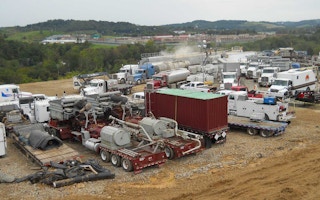A new report by UNCTAD, the UN Conference on Trade and Development, describes natural gas as a useful “bridge fuel” for States aiming to move towards more environmentally-friendly renewable power sources.
But it has disadvantages too, not least the fact that its main component is methane gas, which has a global-warming potential 28 times higher than the carbon dioxide found in other fossil fuels.
The fuel “should contribute…to achieving a low-carbon economy” by 2030, the report says, while pointing to “gaps in local geological and hydrological knowledge” and inadequate regulations that may represent “major obstacles to hydraulic fracturing as a method of extracting shale gas”.
Janvier Nkurunziza, chief of UNCTAD’s Commodity Research and Analysis Section, said that the report was “not saying (fracking) is good or bad”.
That was something that only governments could do, the UN official added, based on variables including their investment capacity and the possible contamination of underground water sources.
“Whether it’s really good, or bad, depends on a number of factors that we analyse in this report: geology, sources of water for example; if you are increasing your water stress by using a lot of water, infrastructure and so on and so forth,” said Nkurunziza, adding that “we are not saying it’s good or bad, just look at the conditions and the region (where) you want to explore this resource, and then you can determine whether you can do it or not.”
Citing data from the United States Energy Information Administration, the UNCTAD report indicates that the world has around 60 years’ worth of shale gas left before the resource is exhausted.
Around half of the 215 trillion cubic metres this represents is in Algeria, Argentina, Canada, China and the United States—although the US is the world’s leading shale gas producer, with 87 per cent of total output.
“The US is like an exception,” said Nkurunziza, noting that no other country has the “huge investments” necessary to fund shale gas exploration on such a scale.
Thanks to this financial strength, the North American giant also became a net exporter of natural gas in July last year, while the country’s massive commitment to liquefaction facilities has also put it on course to hold the third largest processed stock of the energy source in the world, after Australia and Qatar between now and 2020.
Other factors such as land ownership, also explain the US dominance in shale gas exploration, Nkurunziza said, highlighting that in the US, “if you want to use your land to frack it’s up to you”.
The UNCTAD official added that the world’s largest economy also has “highest technology that’s available” for fracking to happen, along with a highly flexible financial system capable of resisting the ups and downs of commodity price changes.
“In the US sometimes when the prices go down they stop fracking, when the prices increase the investments are there, so investors will come and do it, so it’s very flexible”.
This story was published with permission from UN News Centre.










